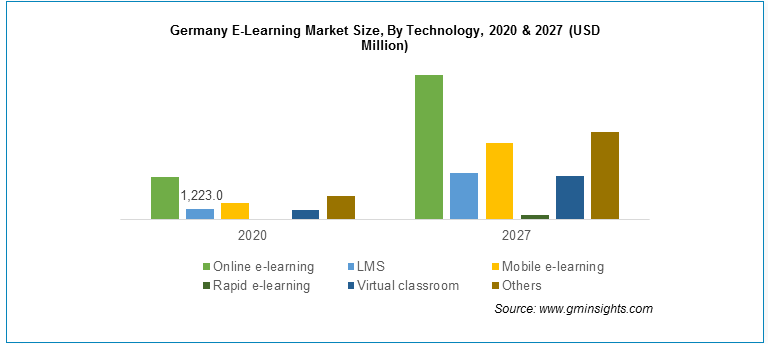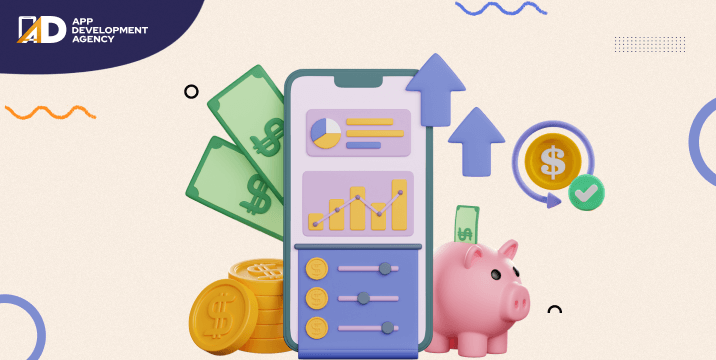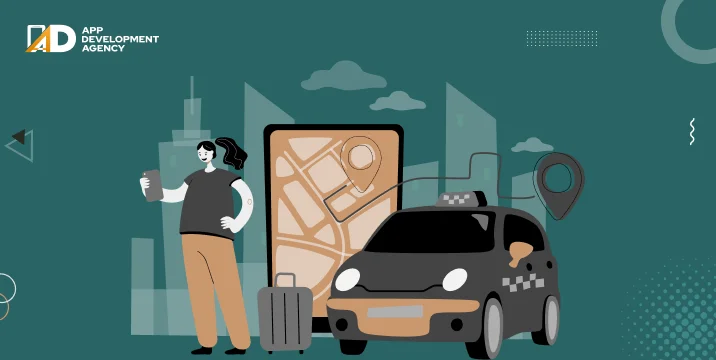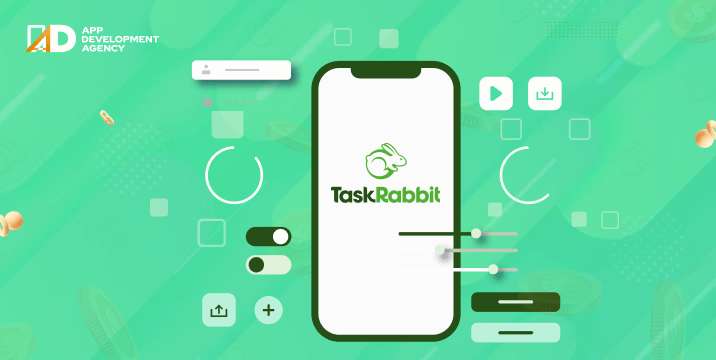We’re discussing some educational app ideas, technology stack and more to churn up your next online Edtech project/Education mLearning Mobile Apps!
Educational applications are improving the learning experience for all students by developing capabilities for research. They get better ways to engage with content, colleges and universities to offer affordable closed captioning for all academic processes.
The market size of e-learning crossed $250 billion and is scalable at an exceptional CAGR of over 21% through 2027. Several new technologies such as artificial intelligence, virtual reality, cloud computing-based learning management system will drive the market growth. Emerging technologies assist in developing content, digitized study guides, and real-time questioning.

(Image Source: https://www.gminsights.com/industry-analysis/elearning-market-size)
Integration of cloud-based technology in learning management systems allows students to access information at any time and place. It enables universities to build a virtual environment for educators and students. It also offers enhanced security to universities with automatic upgrades, updates, fast deployment capabilities, and better encryption for online transactions.

(Image Source: https://www.gminsights.com/industry-analysis/elearning-market-size)
Front-End Technologies
Back-End Technologies
Database
Third-Party Services
Private Tutor App: Apps of this category assist students in taking their online classes effortlessly, finding credible tutors, avail classes via the app. Students get to choose their tutors within budget, select courses of their choice, communicate their concerns, and get their queries resolved.
App for Differently Abled: Apps of this category help people with hearing or visual disabilities.
Flashcard Apps: Such applications help pre-school children to learn while playing.
Dictionary and Thesaurus App: Such applications are gamified versions of complex dictionaries to enhance vocabulary and language skills in younger kids.
Language Learning App: Although non-native English speakers cannot gain fluency in a specific language with a language learning app like Duolingo. Such applications help you to pick up one language, introduce new words, phrases with flashcards, make you listen to exercises, makes you construct sentences, learn grammatical rules and self-improvement projects.
Regional Language Translator App: Educational apps for translating regional languages provide free resources, tools, how-to guides for live captioning and translation in the classroom. Schools can be diverse, and teachers manage many types of learners, including the impaired students in some way. Applications like Microsoft Translator help bridge the communication gaps, supporting accessible classroom learning with live captioning, cross-language understanding, and even multilingual casual conversations to help with student integration.
School Bus Tracking App: Such apps provide a way to route, track the buses, and map view of the location of the buses. Such applications allow track buses from stop to stop, along with the times of arrival and departure from each point. GPS installed in ‘school management systems’ makes it easier for the parents to track the bus and communicate with the driver. It also helps drivers to communicate directly with the parents in case of delays and deviations. The parents can themselves see the causes of the delay on the app. It helps plan the exact routes for each bus with the stops on the way. Optimization of the ‘route’ leads to lesser fuel consumption and reduces operational costs. It allows automatic routing, which saves time spent on manual routing.
Exam Focus Learning App: If students don’t study, chances are they are going to struggle during exams. There can be uncalled distractions and limited time at disposal before actual exams. Such applications have music to remove all distractions and let you study. It has revision cards based on the subjects of your choice. You can randomize tests, flip the deck of revision cards to see how much you remember. There is a multiple-choice option for revision cards so you can quiz yourself. Students can divide their studies into short spins and reward themselves with regular breaks until their next sprint. They can repeat this cycle after every 30 minutes break.
Student Progress Tracking App: Assessment tools help educators in assessing students’ performance. Students can respond to questions and assignments by typing, drawing, or submitting images to show their answers. Such apps offer real-time intervention so teachers know what their students need and can take immediate action. Assignments align according to students’ grades for easy tracking of student progress. Teachers get to upload their rubrics for easy scoring and determine mastery standards for any performance-based assessment.
Student Attendance Tracking App: Student attendance applications assist schools in taking student attendance when remote learning. If teachers are the lifeline of the education system, they equally require students’ support by studying, attending regular classes, doing their homework, and showing up to class. Student Attendance Tracking App prevents entering redundant data. Users need to enter it once, and the app makes it available at any time and anywhere. All the site features are also available on mobile devices.
Student Community App: Apps of this category help students reach their full potential by making them join a diverse community, empower their learning journey, help them connect on shared interests, and discover opportunities, internships, scholarships, and grants, jobs, and careers. It also lets users find friends and win community rewards. Students – (1) showcase their achievements interactively, (2) authentically, (3) define their job objectives, (4) pitch ideas, and (5) make themselves stand out from the crowd.
E-book Reading App for Course Books: Apps like kindle help students, professionals in accessing online libraries to read e-books. E-reader applications let you download and view electronic books and publications on your computer or smartphone. It has built-in navigation to refer back to sections that you ‘are-unable-to’ finish reading at this point. It also lets you perform full-text searches, highlight words and passages within e-books and draw freehand within the reader. Additionally create custom links within e-books on your smartphone and rotate a publication’s screen, auto-scroll pages. It also customizes the reader to its linking.
AI-Based Ed-Tech Apps: Artificial Intelligence enabled applications to help students streamline the education process by providing access to the courses, improve communication with teachers, free up more time to focus on other aspects of life, adapt to each student’s level of knowledge, speed of learning, desired goals so that they get most out of their education. AI-powered solutions can analyze a student’s previous learning histories, identify weaknesses, and offer courses best suited for improvement, providing many opportunities for a personalized learning experience. AI tutors and chatbots (virtual assistants) sharpen students’ skills, and improve weak spots, outside of the classroom. They offer a one-on-one learning experience in absence of a human teacher. Students get access to high-quality education without incurring travelling and living expenses. AI educational apps help educators in automating tasks and checking students’ performance.
ML, AR Based Ed-Tech Apps: Augmented reality brings lessons to life through simulations. It can reconstruct the past, visualize stage design, visualize laboratory experiments, and visualize medical procedures. AR can generate students’ interest by engaging in creating educational content. It allows them to add to curriculum content, virtual word, and explore new interests. It increases engagement, enhances the learning experience, gets students to learn and practice new skills. Augmented technology builds sensory development and benefit students from immersive virtual content that incorporates an experiential learning style in which students carry out physical activities instead of watching a demonstration.
Student To-Do List App: This app category enables students to customize and organize their to-do lists, study sessions, subject-wise study, create priority lists, schedule doubt clearing sessions with their tutors, manage their periodic tests. It is made available across devices. It helps them learn and manage their time better.
No-Code Machine Learning, TinyML, AutoML, Machine Learning Operationalization Management, Full-stack Deep Learning, Generative Adversarial Networks, Unsupervised ML, Reinforcement Learning, ‘Few Shot’ One Shot, & Zero Shot Machine Learning are trending technologies in the eLearning industry. Many technologies in data scientist’s arsenal include – (1) Computer vision, (2) natural language processing, (3) robotics, (4) audio processing, (5) voice cloning, (6) IoT analytics, (7) character recognition, (8) Image classification, (9) Object recognition, (10) Image retrieval, (11) Object Tracking, (12) Specific object counting in images, (13) Gesture recognition, (14) Part labelling, (15) Image generation, (16) Shape view reconstruction for, (17) Image captioning, (18) Video classification, (19) Motion Prediction, (20) Action Localization, (21) Person Re-identification, (22) Event detection. These enable processing applications to complete tasks and remain competitive in the market. Every objective requires different methods to achieve. Check what can help you improve your business efficiency and your vision of supporting your clients.

Story Time: It’s the last of the month… and you have a low balance in your bank account. You need money to pay off an EMI, but salary payday is still two days ahead. Sounds like skating on thin ice… Right? That’s where cash advance apps like Possible Finance come into the picture. ‘Cash Advance …
Continue reading “21 Top Apps like Possible Finance to Get Instant Money in 2024”
Read More
Is the ridesharing industry saturated now? No doubt there are already a lot of best ridesharing apps globally. However, as per Statista, the leading research site, the ridesharing market is expected to grow at 22.13% annually and reach $226 billion dollars by 2028. The numbers are crazy, and to further prove our point – Arro, …
Continue reading “14 Best RideShare Apps in 2024”
Read More
Imagine… you and your beloved partner are out for a lovely dinner and suddenly realize that you slipped bringing food to your dog who is currently starving at home. You do not want to ruin the dinner date and hope that someone could go to the market for you, bring some dog food, and then …
Continue reading “14 Apps Like TaskRabbit to Make Money in 2024”
Read More